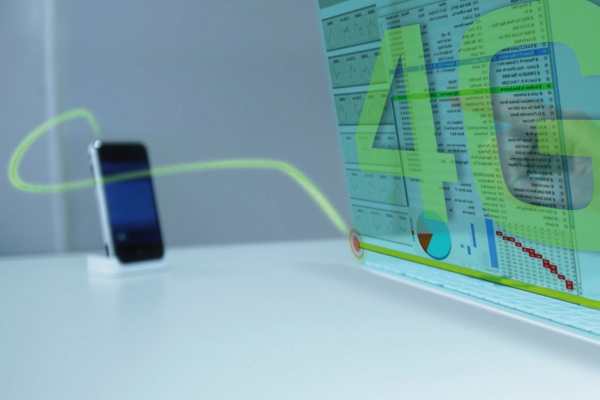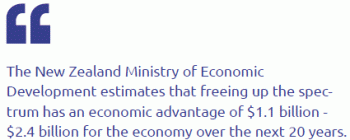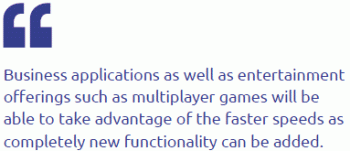Published on the 21/12/2010 | Written by Nigel Horrocks

True 4G offers the hope of blistering mobile broadband speeds, but it can’t happen until access to the spectrums currently occupied by analogue TV are released – and that’s a few years away yet…[View as PDF]
Governments in New Zealand and Australia have confirmed dates for the end of analogue TV transmission, something the US, Britain and Europe have also almost moved forward with. The transition is underway in Australia. New Zealand homes, from November 2013, will need to have a digital TV facility such as Freeview or SKY TV, if they wish to continue to view television.
Less well known is that this also means that the frequency space presently occupied by analogue television becomes freed up, and the benefactor will be mobile operators. It’s prized space for them because it is ideal for the next wave of mobile technology, and it is technology that can potentially end the problems the rural communities have in presently accessing fixed line broadband.
The technology in question is known as LTE or light-term evolution and this 4G generation technology promises ultra fast broadband on wireless mobile networks. It’s capable of delivering speeds of between 100Mbit/s and 200Mbit/s which is up to ten times faster than the fastest broadband speeds being seen at the moment. With more powerful transmitters, a wireless network can now extend across many kilometres.
The 700MHz ban is not just enabling faster mobile signals but the signals have a longer range and can better penetrate through concrete walls reducing the problem that users, especially those with smartphones, complain about with dropped calls and difficulty accessing mobile broadband data or putting up with slow speeds for the internet. The mobile companies also see potential now that technology companies, spearheaded by Apple, are moving to wireless tablets, iPads and e-book readers.
| What is LTE? • Faster speeds • Benefits for the rural sector • Easier video conferencing • Wireless penetrating concrete walls better • Latency improvements for activities like multiplayer gaming • Fewer dropped calls • Enhanced security • Seamless international roaming Advantages of LTE • It will deliver users the benefits of faster data speeds and new services • It’s a new radio access technology that’s optimised for IP-based traffic • Mobile operators get a simple upgrade path from their 3G networks • LTE is the result of ongoing work by the 3rd Generation Partnership Project (3GPP), a collaborative group of international standards organizations and mobile-technology companies • An aim is that the networks must transmit data at a reduced cost per bit compared to 3G • It uses open interfaces and offer a simplified architecture |
The US example
The US headed down the path of switching off analogue television last June, long before New Zealand and Australia set the dates of 2013 but it hasn’t been an easy ride for those wanting to snatch the spectrum.
Legal argument has raged over the use of the so-called “white spaces.”
That refers to the unused spectrum between broadcast television channels, the free space that the big telecommunication firms, and now other technology companies, want to use for their next generation networks.
It’s not just the mobile companies who see their future resting on 4G. Some of the biggest global technology players see it as part of the next battle for dominance.
Google, Microsoft and Dell were among those who put their hands up for a share of that spectrum.
Microsoft began experimenting around their giant Washington campus.
That campus, which is as vast and spread as a big university, relies on a shuttle service to get people fast across the various buildings. The company thought it was an ideal space in which to experiment with how technology coped using the white spaces available. It tested gadgets to see how they performed when transported between the companies 100-plus office buildings. Microsoft has now obtained an FCC permit to experiment in more realistic settings beyond their campus. It is fitting that Microsoft has been experimenting in its own campus-type setting. Demand for fast broadband is growing fast at university campuses – both from students studying and living on campus but also so that e-learning technologies can be explored.
It’s considered that the new 4G technology could be a godsend for large universities. Especially attractive for universities is the possibility of the faster speeds and – for a campus spread over a large distance- the fact that signals can penetrate thick concrete walls. Already, in the US, Verizon Wireless is experimenting with a 4G LTE network in West Lafayette, Indiana, home of Purdue University. The public university is using several innovative software applications on Verizon Wireless’ network to see if they improve student engagement and success, and Verizon Wireless is working with Purdue to explore the next phase of how 4G LTE technology can improve e-learning across the nation. This provides an alternative option to the widely used WiFi networks on campuses, which has its own security issues.
Dolly takes on Google
For two years until last September, a strange grouping of entertainers and preachers has been trying to stop technology companies’ endeavours. Nashville’s Dolly Parton, remembered for hits like the 1980 movie theme “9 to 5”, led the charge along with heavy metal group Guns ‘n’Roses, Neil Diamond, and the Dixie Chicks, some US broadcasters and evangelical church ministers who are used to addressing large, often outdoor, gatherings.
In fact, wireless microphones are used daily by thousands from people making recordings at home to giant sporting gatherings.
Their argument was that for their large outdoor performances, they use powerful wireless microphones and those microphones use the “white spaces” that are up for grabs. They feared there would potentially be interference from mobile calls if mobile companies were also using the spectrum. TV broadcasters also claimed that the use of the white spaces could seep into their channels. The arguments were finally rejected.
The Federal Communications Commission (FCC) said that it would set new rules to prevent any chaos. It would create a database of spectrum currently occupied by TV stations and any new devices used in the spectrum would be checked against the list to make sure there was no crossover.
An area of the spectrum would also be set aside specifically for wireless microphones.
Microsoft has also designed a set of protocols it called “White-Fi,” which is believes would prevent interference.
Under those protocols, devices are able to check for any potential interference and can move to a backup frequency slightly “down the dial” if that is the case. Microsoft says regular Wi-Fi networks weren’t designed to sense outside interference but almost every corner coffee shop is offering wireless and has a wireless router so frequencies are getting congested and the chance for interference has increased.
 Your fridge is on standby
Your fridge is on standby
It has been two decades since the FCC had granted use of any unlicensed spectrum. Back then, no-one knew what to do with the band but new uses were soon discovered. In fact, it unleashed the use of some new previously unexplored uses of the spectrum such as ways to open garage doors and, for parents, radio devices to monitor if their baby was waking up in the other room. The new spectrum could well spark some new ways to communicate around your home.
Dell is suggesting, as an example, the idea of your refrigerator sending out some sort of signal to your iPad or computer to warn you it has detected food stocks that are running low and to advise that it has automatically connected to the online supermarket and ordered more.
You may have reservations about your refrigerator making important household shopping decisions but it does illustrate how a new-look smart phone or device may eventually emerge using the new wireless technology in a way only sci-fi books and movies talked about in previous years. The internet refrigerator isn’t a new concept but the suggestion is now our lifestyle will embrace mobile even more.
No need to travel
One lesson many businesses learnt during the recession was that videoconferencing saved valuable time and money but the downside is the frustration of stuttering video and difficult audio to comprehend.
Recent personal experience highlighted that we are not there yet. I took part in an inter city conference recently and “frustrating” would be a polite way to describe the experience. At my end, participants were definitely disadvantaged as they sometimes strained to hear, video was lost or delayed and opportunities to jump into the discussion were impossible.
It’s hoped that the new 4G experience will put those problems to rest.
LTE promises video applications on the downlink as well as the uplink enabling better video sharing, surveillance, video conferencing and video streaming in higher definition than is possible with the existing 3G technology.
Those who have experimented with it say that when a newspaper was held up during videoconferencing, participants at the other end could easily read the words, showing how clear it was.
Skype apps are growing in popularity for smartphone users connecting via Wi-Fi, and will be even more popular once 4G is available, to the potential detriment of fixed line phone companies’ toll call traffic. It may even hasten mobile to mobile video calls which Apple played up as a feature when it launched a new version of its iPhone. Such video calling has been available for years on some phones and networks but for the reasons such as those above, the feature has yet to make it a crowd winner.
There will be other economic savings. The New Zealand Ministry of Economic Development estimates that freeing up the spectrum has an economic advantage of $1.1 billion – $2.4 billion for the economy over the next 20 years due to the lower costs of deploying mobile networks in the 700 MHz band, resulting in lower costs for consumers.

The technology
Fast widely available internet on 4G is made possible using either of two main technologies, known as Long Term Evolution and WiMax. LTE is the standard from the industry group, 3GPP that brought out 3G. That US wireless industry trade association has been operating for more than eight years, and has actually changed its name to 4G Americas to reflect the upcoming move to 4G. LTE is a new wireless interface using IP and designed for broadband data firstly with voice added later – the reverse of previous wireless technology. In the end, it seems LTE will win out with those offering WiMax likely to covert to LTE to make it a common global wireless standard. There will be some 4G-only devices in the early days but it will be some years before 2G and 3G are ever phased out.
Around the world
Australia’s Telstra has already begun trials of LTE working with Nokia Siemens Networks, Huawei and the carrier’s long term supply partner, Ericsson. In June, the firm announced that, together with NSN, it had successfully achieved LTE network speeds of 100Mbps over a distance of 75km in the 2.6GHz band. Shortly afterwards, in July, it said it had completed a trial of LTE in the 1800MHz band with Huawei.
In the US, Sprint has been investing in WiMax-based 4G since 2006 and is the only one of four main carriers currently offering 4G among the four major carriers. It has rolled it out in 55 markets so far. Other US carriers have plans for 4G or have started testing, with LTE the most favoured overall choice among US carriers.
In Las Vegas, Metro PCS has launched the first commercially available LTE 4G network in the US.
Customers can get unlimited talk, text and data for around $72 a month.
Verizon Wireless is launching in 38 markets in the next few months and will have rolled out throughout the US by 2013.
It says the initial 38 areas could potentially cater for more than 110 million Americans. In addition, the company is launching 4G LTE in more than 60 commercial airports coast to coast – namely the airports within the launch areas as well as airports in other key cities. A company spokesman says its vision is to provide ubiquitous wireless broadband connectivity and mobility to rural and urban Americans alike.
One of the biggest contracts announced so far is the awarding to Harbinger Capital Partners of an eight-year, US$7 billion contract to Nokia Siemens Networks to provide the network design and equipment for its wholesale LTE network. The Financial Times reported that this would be run by a new venture called LightSquared and launched in the second half of 2011.
The report said that the network will allow for terrestrial-only, satellite-only or integrated satellite-terrestrial services (via the terrestrial and MSS spectrum Harbinger scored through a merger in March with satellite operator SkyTerra) – a notable selling point in a wireless market divided between ground-based cellular networks and satellite offerings from the likes of Iridium and others. Japan, Russia and Korea are among the countries with WiMax networks.
Fit for a Royal Wedding
In Sweden, TeliaSonera became the first operator in the world to commercially launch 4G. It is offering customers in Sweden and Norway 4G mobile broadband speeds up to a maximum speed of 100 Mbit/s.
It claims the speeds will be ten times faster than 3G.
During the first half year of this year, TeliaSonera has also opened up 4G for pilot customers in Finland, Denmark, Lithuania, Estonia and Latvia.
During the Swedish Crown Princess’ Royal Wedding in June, Swedish TV companies carried live broadcasts  via 4G from the celebrations in Stockholm. The company promotes 4G as “opening up new possibilities for customers to enjoy services on their laptops, which require high transmission speed and capacity, such as advanced web TV broadcasting, extensive online gaming and web conferences. On top of that, we add on the mobility dimension.” The 4G/LTE core network is being delivered by Ericsson and the radio networks by Ericsson and Nokia Siemens Networks. As an aside, the TeliaSonera subsidiary in Nepal, Ncell, has successfully launched 3G services in the Mount Everest area meaning mobile is now available in the highest part of the world.
via 4G from the celebrations in Stockholm. The company promotes 4G as “opening up new possibilities for customers to enjoy services on their laptops, which require high transmission speed and capacity, such as advanced web TV broadcasting, extensive online gaming and web conferences. On top of that, we add on the mobility dimension.” The 4G/LTE core network is being delivered by Ericsson and the radio networks by Ericsson and Nokia Siemens Networks. As an aside, the TeliaSonera subsidiary in Nepal, Ncell, has successfully launched 3G services in the Mount Everest area meaning mobile is now available in the highest part of the world.
Software gets an upspeed
While the attention around 4G is to do with broadband, the new blistering speeds also provide opportunities for software makers.
Verizon Wireless is participating in a 4G innovation lab which has pledged up to $1.3bn for development to fund new ideas and test concepts. Business applications as well as entertainment offerings such as multiplayer games will be able to take advantage of the faster speeds as completely new functionality can be added. New software will be born.

A Verizon developer conference in September had sessions exploring how 4G could create entirely “new business models and product categories.”
Besides software developers, the list keeps growing of who may benefit. Chip vendors, device vendors, network infrastructure vendors and network operators are all in line.
How much?
Because of the size of New Zealand and the number of potential players, don’t expect insane prices to be paid for the spectrum but any spectrum still doesn’t come cheap, let alone the infrastructure needed.
One estimate suggested the total may be in the vicinity of $100m. The timeline for the sale, likely by an auction process, has yet to be drawn up, but at this stage, it’s thought to be in 2012. Importantly, fewer cell sites are needed, so networks may be cheaper than previous networks to build.
In the past, the number of bidders versus available spectrum triggered high prices in auctions overseas, including in the UK where bidders for 3G ended up giving the British government a $48b windfall. A recent German spectrum auction following the TV switchover was more realistic on price.
Reasons put forward for this were that there were no new bidders other than the usual providers, and there were strict requirements about successful bidders having to provide for uneconomical rural areas as part of the conditions of sale.
|
When here?
Vodafone is well advanced with plans to build a 4G LTE for around the end of 2013 and when iStart spoke to officials, a technology demonstration with Nokia Siemens was being arranged for Wellington.
Vodafone says it’s especially excited about the possibilities 4G has for the rural area and the raw speeds possible.
Sharing a network with another carrier (such as 2Degrees) was not ruled out but there were Resource Management Act issues around the height of celltowers.
Telecom, in announcing its XT network, said its choice of technology placed it “in a strong position to take its customers to the ultimate in speed and performance by providing a pathway to LTE.” It noted at the time that Telecom’s technology partner Alcatel-Lucent had been selected by Verizon Wireless to build its LTE 4G network in the US. That Verizon network will be backward compatible with 3G.
| The TV changeover • The United States and parts of the EU have already completed the analogue TV change. • The United Kingdom switchover will be completed in 2012. • Australia is aiming to complete it in late 2013. • 70% of homes with TVs have already switched at least one set to digital. • Digital television is popular with viewers with nine per cent of households having both Freeview and Sky/ TelstraClear. • The quality of signal transmission and awareness of digital television are contributing factors to the variation in regional uptake. • There is regional variation in levels of digital uptake:
|
































